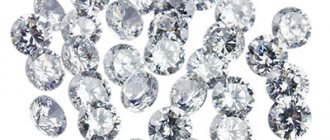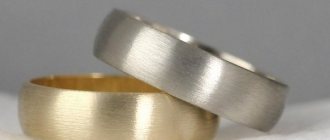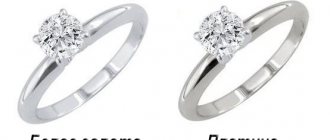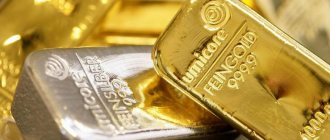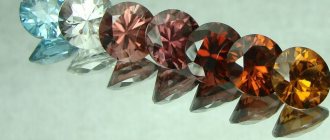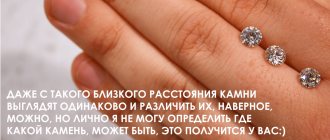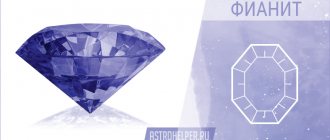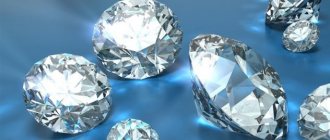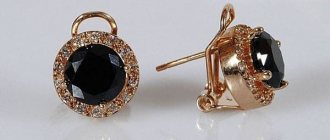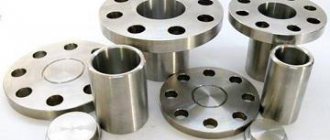Most people who want to purchase jewelry often wonder what is more expensive: zirconium or cubic zirconia. At the same time, they come across such names as zirconium, zircon and cubic zirconia. Jewelry sellers use these words, often without understanding the differences. In reality, these are three completely different minerals. Zirconium is a rare metal and is not used in jewelry production. Its artificial analogue, cubic zirconium, is called cubic zirconia. Zircon is a natural gemstone, rare in nature and very valuable.
Zirconium is a metal
You may be interested in: Cartier bracelets with a screwdriver: the secrets of a jewelry legend
Zirconium is a chemical element on the periodic table with atomic number 40. It is a simple substance, a metal, and the color is silver-gray. Among its main characteristics are high ductility and corrosion resistance. Zirconium does not exist in nature in its pure form. It was first obtained as dioxide only in 1789 due to chemical transformations of zircon, which is a natural zirconium silicate.
Historical reference
You may be interested in:Silver bracelets “Sokolov”: review, description and reviews
Pure zirconium, free from impurities, was isolated only in 1925.
To date, the exact origin of the word “zircon” has not been established. Some researchers believe that it has its origins in the Arabic zarkun, meaning cinnabar, or comes from the Persian zargun (golden).
The largest deposits of minerals containing zirconium are located in India, Australia, Brazil, and the USA. The expanses of Russia are also rich in this metal; the country accounts for almost 10% of its world reserves. Thus, geologists have established that ores with zirconium are available in almost unlimited quantities on the Kola Peninsula, in the magmatic outcrops of the Khibiny massif.
There are a lot of compounds that contain zirconium in nature. However, it is found only in association with oxygen, as oxides or silicates. The main mineral in which it is present is native and gemstone zircon.
Natural gem zircon
You may be interested in: How to distinguish a diamond from cubic zirconia in a ring: external differences and properties
Zircon is a fairly expensive natural gem. Its cost is comparable to sapphire. In its physical properties and natural beauty it is not inferior to most gems. This transparent stone comes in a variety of colors. It has a strong shine. Previously, in the East, this characteristic was noted separately, referring it to the younger brother of the diamond.
Jewelry with this gem has been known since ancient times. In the Middle Ages, jewelers, not knowing the true physical and chemical nature of zircon, classified it as an imperfect and undeveloped diamond by nature. Noting the significantly lower hardness of the stone and not such a strong shine after cutting. The fact that diamond has nothing to do with zircon and is only a single crystal of the zirconium metal became known much later.
Zircon comes from igneous rocks. Its color is determined by the various chemical elements that are present in it. Jewelers mainly prefer transparent zircon crystals. Which colors are pink, reddish brown and golden yellow.
Well-known varieties of zircon are: hyacinth in red-brown or orange shades, jargon yellow-straw, and green zircon.
Natural zircon is practically never found separately as a stone in jewelry stores. The main production of this mineral is carried out in the southeast, in Thailand, Burma, on the island. Ceylon. The majority of jewelry zircons, the deposits of which are extremely rare, originate from alluvial placers in Sri Lanka. Madagascar and Thailand.
We must remember that in jewelry, jewelry with the presence of zircon must be approached with caution. This stone is quite fragile and can break. Small zircons can lose their sparkle if they are not properly cared for.
"Technical" differences
When producing stones in laboratory conditions, scientists try to achieve the most identical properties that are inherent in natural gems, and they succeed in this. Almost all synthetic specimens have hardness, appropriate density, a beautiful glow fracture, the absence of cleavage and various effects that natural gems have.
| Properties | Zircon | cubic zirconia |
| Density | 4.680—4.710 g/cm³ | 6.5-10 g/cm3 |
| Hardness | 7-8 | 7,5-8,5 |
| Cleavage | imperfect | absent |
| Impurities | oxides of hafnium, aluminum, calcium and iron, as well as tin, copper, chromium, manganese | cerium, chromium, neodymium, erbium, titanium |
If, when purchasing, you still doubt the authenticity of the gem, then the best solution would be to contact a specialist who, using special equipment, will quickly determine whether it is zircon or cubic zirconia.
Artificial cubic zirconia stone
Cubic zirconia is an artificial material, zirconium dioxide. It has a crystalline cubic lattice. The main application is jewelry, where it acts as a simulator of precious stones. Rings and earrings with cubic zirconia are especially popular.
You may be interested in:Sunlight stores: customer reviews of jewelry
Cubic zirconia, zirconium dioxide, is an unstable chemical element in its chemical and physical properties. Its stabilization is achieved through the addition of yttrium, calcium, and manganese oxides.
Cubic zirconia has a high refractive index of light, close to that of diamond. As a result, non-specialists cannot always distinguish it from this expensive stone.
Cubic zirconia is obtained chemically, through industrial crystallization. Initially, this mineral is colorless, to which color shades are added by the inclusion of transition and rare earth elements.
Thus, the addition of cerium gives orange, yellow and red colors. Chrome colors cubic zirconia green, neodymium purple. Titanium metal provides the crystal with a golden-brown hue, and irbite gives it a pink color.
Chemical composition and physical properties
Zircon is zirconium silicate. Natural semi-precious mineral. Chemical formula: Zr[SiO4]. The stone can be colorless or have a color that depends on the presence of impurities in its composition - copper, iron, titanium, zinc. The most beautiful and valuable specimens of jewelry quality are considered to be golden-yellow stones - jargons, and rare red ones - hyacinths; blue, green and black zircons are also found.
Zircon crystals have a bright, diamond-like luster, which is why they are often used as imitation diamonds in jewelry. It is noteworthy that the bright green large minerals contain radioactive components and can be a rather dangerous source of radiation.
Natural green zircon
Cubic zirconia is zirconium dioxide - ZrO2, also called cubic zirconium. This is an artificially grown mineral. At first glance, it is hardly distinguishable from faceted zircon, but the refractive index of cubic zirconia is much higher, and its optical properties are very similar to diamond. The color of the stone can be different and depends on the additives introduced.
cubic zirconia
Diamond
Origin, history of the name
Cubic zirconia owes its name to the Physical Institute of the USSR Academy of Sciences. It was the physicists of this structure who synthesized it in 1975.
Initially, scientists conducted experiments to create crystals that could improve the optical properties of the laser. Their work led to the creation of a mineral that resembles a diamond in appearance. But I have not found any practical application in laser technologies. However, it has become one of the world's most popular gem imitators. Due to the fact that it is of artificial origin, it is not a precious stone.
However, this name was assigned to the artificial mineral only in the countries of Eastern Europe and in the republics of the former USSR. In other countries it is usually called zirconite.
Modern technology for the production of cubic zirconia has been developed. These crystals grow quite quickly, approximately 8-10 mm per hour. An industrial installation provides several thousand of these stones per day. As a result, the cost of cubic zirconia is low.
Cubic zirconias are used as inserts to decorate jewelry, mainly made of gold and silver. In costume jewelry, their use provides contrast to various compositions, including as imitation diamonds.
It should be noted that there is also natural cubic zirconia, which is called tezheranite. It was first found in 1966 near Lake Baikal, in the Tezharan Gorge, which gave it its name.
This is a natural nugget of red or orange color. Its dimensions are small, up to 1.5 mm, which does not allow it to be used in jewelry.
Swarovski crystals
Swarovski crystals are not diamonds or glass. This is artificially processed crystal of exceptional transparency. Swarovski crystals are made from more than 70 components, most of which are classified. All of them are exclusive, because they are cut by hand, and absolutely symmetrical. All edges of the stones are carefully polished. There is not a single micro scratch or crack on them!
In addition to crystal (Swarovski Crystall), the company is known for its cubic zirconia (Swarovski Zirconia), as well as topazes, sapphires, rubies, garnets, peridot, quartz, citrines, which occupy high positions in the world in terms of quality of processing.
Swarovski artificial cubic zirconia can be found in more than 20 colors. They are made in special laboratories in two ways:
- Up to 1 carat is grown in a chamber at a temperature of 1400–1600 °C for 5 days.
- It is obtained by chemical deposition using a mixture of methane + hydrogen gases.
For the fourth year now, Jewelry Karta has been collaborating with the world-famous supplier of jewelry inserts, Swarovski. We strive to use only the best materials for our collections, so we have launched a separate line of jewelry with Swarovski Zirconia cubic zirconia inserts, as well as natural stones from Swarovski Gems. Jewelers from South Caucasus inlay their products with white and colored stones. Depending on the processing method, stones in rings, earrings, pendants and pendants can take on a round, convex shape (cabochon), teardrop-shaped (in “paws” made of gold), or a heart shape.
What is more expensive - zirconium or cubic zirconia?
In order to understand the difference in the cost of zirconium and cubic zirconia, you need to get an idea of what is offered by modern jewelers on the market.
Practice shows that sellers themselves often cannot understand the difference, calling natural zircon zirconium, and zirconium dioxide – zircon, not cubic zirconia.
So how to distinguish zirconium from cubic zirconia?
The zircon gemstone, which is commonly called zirconium, is a naturally occurring rare mineral. Cubic zirconia is an artificial, synthetic, inexpensive stone. It is difficult for non-specialists to distinguish them at first glance, and for this you need to know some secrets.
So, we must remember that natural stones cannot be perfectly clean. They must contain voids and inclusions. If they are not there, then with a high degree of probability it is an artificial stone.
Cubic zirconia and zirconium. What else is the difference? In weight. Artificial zircon is much heavier than its natural counterpart.
The color of fiana is bright, the shine is rich. Natural zircons have a specific discreet diamond shimmer.
Taking into account the fact that these are two minerals of different origin (natural and artificial stone), the question of what is more expensive - zirconium or cubic zirconia - is decided in favor of the first.
What is the difference?
The difference between minerals is visible only to jewelers. It consists of the following:
| cubic zirconia | Zircon |
| Mineral found in laboratory | Has a natural origin, metal |
| Perfectly transparent | Has small inclusions and voids inside |
| Hardness 8 | Hardness 6 |
| More bright | The cost is higher than that of cubic zirconia |
| Heavier | Lightweight, soft to handle |
Zircon prices
Not everyone can afford this gem. Its cost is directly dependent on the color of the stone. Modern jewelers use mainly brown, red, green and blue minerals. In terms of cost, those with blue colors come first. Next in descending order are red and green. The cost of stones with brown tints is much lower. With other colors it’s even cheaper.
Currently, prices on the market are approximately the following: blue zircon costs from 170 to 400 US dollars per carat (a generally accepted unit of mass, equal to 200 mg - 0.2 g). The cost of green and red minerals ranges from $150 to $250. Brown zircons cost between $100 and $150 per carat. Prices for zirconium of other colors are 5-15% lower than those with brown shades.
During the Middle Ages, zircons with red-brown and bright red hues, also called hyacinths, were considered very popular gemstones. They were valued a little less than pearls. However, at present, interest in them has dropped significantly. Hyacinths are mainly in demand among people who are interested in paranormal phenomena and are interested in esotericism.
